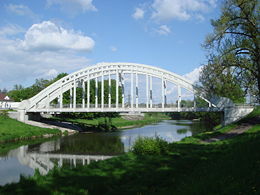
Darkov
Encyclopedia

Karviná District
Karviná District is a district within the Moravian-Silesian Region of the Czech Republic. Its administrative center is the city of Karviná. It was created by 1960 reform of administrative divisions in the area of former Fryštát District...
, Moravian-Silesian Region
Moravian-Silesian Region
Moravian-Silesian Region , or Moravo-Silesian Region, is one of 14 administrative Regions of the Czech Republic, until May 2001 it was formerly called the Ostrava Region . The region is located in the north-eastern part of its historical region of Moravia and in most of the Czech part of the...
, Czech Republic
Czech Republic
The Czech Republic is a landlocked country in Central Europe. The country is bordered by Poland to the northeast, Slovakia to the east, Austria to the south, and Germany to the west and northwest....
, now administratively a part of the city of Karviná
Karviná
Karviná is a city in Moravian-Silesian Region of the Czech Republic, on the Olza River. It is administrative center of Karviná District. Karviná lies in the historical region of Cieszyn Silesia and is one of the most important coal mining centers in the Czech Republic. Together with neighboring...
. Till 1948 it was a separate municipality. It lies on the Olza River
Olza River
is a river in Poland and the Czech Republic, the right tributary of the Oder River. It flows from the Silesian Beskids through southern Cieszyn Silesia in Poland and Frýdek-Místek and Karviná districts of the Czech Republic, often forming the border with Poland. It flows into the Oder River north...
, in the historical region of Cieszyn Silesia
Cieszyn Silesia
Cieszyn Silesia or Těšín Silesia or Teschen Silesia is a historical region in south-eastern Silesia, centered around the towns of Cieszyn and Český Těšín and bisected by the Olza River. Since 1920 it has been divided between Poland and Czechoslovakia, and later the Czech Republic...
. Darkov has a population of 406 (2001).
It was first mentioned in a written document in 1447 as Darkow.
According to the Austrian
Austria-Hungary
Austria-Hungary , more formally known as the Kingdoms and Lands Represented in the Imperial Council and the Lands of the Holy Hungarian Crown of Saint Stephen, was a constitutional monarchic union between the crowns of the Austrian Empire and the Kingdom of Hungary in...
census of 1910 the village had 2,305 inhabitants, 2,261 of whom had permanent residence there. The census asked people for their native language, 2,181 (96.4%) were Polish-speaking. The most populous religious group were Roman Catholics with 2,042 (88.6%) followed by Protestants with 223 (9.7%).
After the division of Cieszyn Silesia
Cieszyn Silesia
Cieszyn Silesia or Těšín Silesia or Teschen Silesia is a historical region in south-eastern Silesia, centered around the towns of Cieszyn and Český Těšín and bisected by the Olza River. Since 1920 it has been divided between Poland and Czechoslovakia, and later the Czech Republic...
in 1920, the village became part of Czechoslovakia. Following the Munich Agreement
Munich Agreement
The Munich Pact was an agreement permitting the Nazi German annexation of Czechoslovakia's Sudetenland. The Sudetenland were areas along Czech borders, mainly inhabited by ethnic Germans. The agreement was negotiated at a conference held in Munich, Germany, among the major powers of Europe without...
, in October 1938, Darkov and the whole Zaolzie
Zaolzie
Zaolzie is the Polish name for an area now in the Czech Republic which was disputed between interwar Poland and Czechoslovakia. The name means "lands beyond the Olza River"; it is also called Śląsk zaolziański, meaning "trans-Olza Silesia". Equivalent terms in other languages include Zaolší in...
region was annexed by Poland
Second Polish Republic
The Second Polish Republic, Second Commonwealth of Poland or interwar Poland refers to Poland between the two world wars; a period in Polish history in which Poland was restored as an independent state. Officially known as the Republic of Poland or the Commonwealth of Poland , the Polish state was...
. The village was then annexed by Nazi Germany
Nazi Germany
Nazi Germany , also known as the Third Reich , but officially called German Reich from 1933 to 1943 and Greater German Reich from 26 June 1943 onward, is the name commonly used to refer to the state of Germany from 1933 to 1945, when it was a totalitarian dictatorship ruled by...
at the beginning of World War II
World War II
World War II, or the Second World War , was a global conflict lasting from 1939 to 1945, involving most of the world's nations—including all of the great powers—eventually forming two opposing military alliances: the Allies and the Axis...
. After the war it was restored to Czechoslovakia.
The village is well-known for its Darkov Spa facilities, established in 1866 which treats various diseases, mostly diseases of locomotive organs, conditions after accidents and operations etc. It has one of the best iodine
Iodine
Iodine is a chemical element with the symbol I and atomic number 53. The name is pronounced , , or . The name is from the , meaning violet or purple, due to the color of elemental iodine vapor....
-bromine
Bromine
Bromine ") is a chemical element with the symbol Br, an atomic number of 35, and an atomic mass of 79.904. It is in the halogen element group. The element was isolated independently by two chemists, Carl Jacob Löwig and Antoine Jerome Balard, in 1825–1826...
waters in Central Europe.
Prominent landmark is a bridge on the Olza built in 1924-1925, located just near the spa. In 1991 it was inscribed on the state register of technical landmarks. It was renovated in the 2000s.
Darkov together with neighboring villages suffered of under-mining caused by nearby coal mines. This affected the character of the village as many inhabitants relocated to nearby villages and towns, thus seriously depopulating the village.

